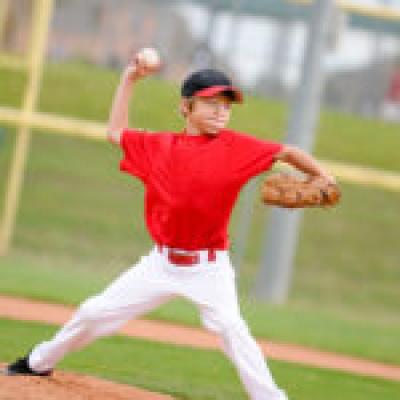Common Throwing Injuries of the Elbow
Flexor Tendinitis
Repetitive throwing can irritate and inflame the flexor/pronator tendons where they attach to the humerus bone on the inner side of the elbow. Athletes will have pain on the inside of the elbow when throwing, and if the tendinitis is severe, pain will also occur during rest.
Ulnar Collateral Ligament (UCL) Injury
The ulnar collateral ligament (UCL) is the most commonly injured ligament in throwers. Injuries of the UCL can range from minor damage and inflammation to a complete tear of the ligament. Athletes will have pain on the inside of the elbow, and frequently notice decreased throwing velocity.
Valgus Extension Overload (VEO)
During the throwing motion, the olecranon and humerus bones are twisted and forced against each other. Over time, this can lead to valgus extension overload (VEO), a condition in which the protective cartilage on the olecranon is worn away and abnormal overgrowth of bone — called bone spurs or osteophytes — develop. Athletes with VEO experience swelling and pain at the site of maximum contact between the bones.
Olecranon Stress Fracture
Stress fractures occur when muscles become fatigued and are unable to absorb added shock. Eventually, the fatigued muscle transfers the overload of stress to the bone, causing a tiny crack called a stress fracture.
The olecranon is the most common location for stress fractures in throwers. Athletes will notice aching pain over the surface of the olecranon on the underside of the elbow. This pain is worst during throwing or other strenuous activity, and occasionally occurs during rest.
Ulnar Neuritis
When the elbow is bent, the ulnar nerve stretches around the bony bump at the end of the humerus. In throwing athletes, the ulnar nerve is stretched repeatedly, and can even slip out of place, causing painful snapping. This stretching or snapping leads to irritation of the nerve, a condition called ulnar neuritis.
Throwers with ulnar neuritis will notice pain that resembles electric shocks starting at the inner elbow (often called the “funny bone”) and running along the nerve as it passes into the forearm. Numbness, tingling, or pain in the small and ring fingers may occur during or immediately after throwing, and may also persist during periods of rest.
Ulnar neuritis can also occur in non-throwers, who frequently notice these same symptoms when first waking up in the morning, or when holding the elbow in a bent position for prolonged periods.
Cause
Elbow injuries in throwers are usually the result of overuse and repetitive high stresses. In many cases, pain will resolve when the athlete stops throwing. It is uncommon for many of these injuries to occur in non-throwers.
In baseball pitchers, rate of injury is highly related to the number of pitches thrown, the number of innings pitched, and the number of months spent pitching each year. Taller and heavier pitchers, pitchers who throw with higher velocity, and those who participate in showcases are also at higher risk of injury. Pitchers who throw with arm pain or while fatigued have the highest rate of injury.
Symptoms
Most of these conditions initially cause pain during or after throwing. They will often limit the ability to throw or decrease throwing velocity. In the case of ulnar neuritis, the athlete will frequently experience numbness and tingling of the elbow, forearm, or hand as described above.
If you’re having pain, please contact one of the Orthopedic Specialists at Aspen Orthopedics, call (262) 395-4141 or request an appointment online.
Information courtesy of www.orthoinfo.aaos.org
(https://orthoinfo.aaos.org/en/diseases--conditions/elbow-injuries-in-th…)

